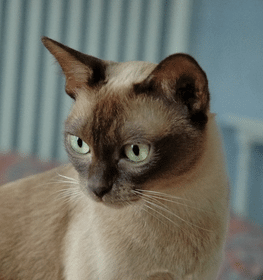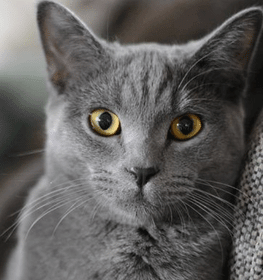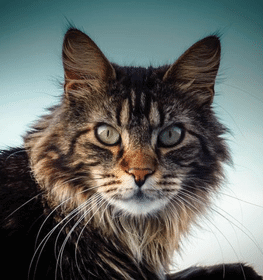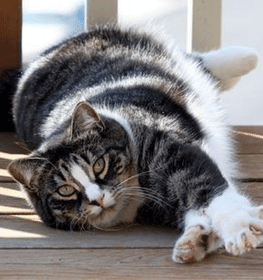European Burmese Cat Breed Information and Facts
This page is about the European Burmese cat breed information and what it means to own one as a companion animal. If you are considering getting European Burmese cat breed, this profile will be helpful in deciding whether or not they are right for you!
| Group | Natural |
|---|---|
| Popularity Rank | 70 |
| Reviews | 0 |
| User Ratings | |
|
Compare the European Burmese With Other Cats
Select at least one cat breed to make the comparsion. | |
 | |
| Origin | |
|
Other Names
What other names are there for the European Burmese cat? | Copper catBritish Burmese |
|---|---|
|
Price
What is the cost of a European Burmese cat? | $600 to $1000 If you choose to purchase the European Burmese cat, you should know that the mentioned amount of money is an average of the collected data from breeders’ sites and cat finder places. If you have a European Burmese cat for sale, please advertise it on a reliable website to make sure the European Burmese gets to a happy place. |
| Cost Of Ownership | Moderate |
| Breed Recognition | The International Cat Association (TICA)Cat Fanciers' Association (CFA) |
|
Size
How big is a European Burmese cat? | Medium The medium-sized cats usually weigh 10-15 pounds and are 8-11 inches long from the nose down. |
|---|---|
|
Weight
What is the weight of the European Burmese cat? | Male: 10-14 pounds, Female: 7-10 pounds |
| Bite Force | Weak Bite Strength: Less than or around 10 PSI A weak cat bite strength, generally measuring less than or around 10 PSI, is often characteristic of smaller cat breeds like the European Burmese or those with less-developed jaw muscles. Cats with weak bite strength pose a lower risk of causing significant harm during a bite. Nevertheless, understanding feline body language and proper socialization are vital for pet owners to prevent biting incidents. Cat enthusiasts researching gentle-biting cat breeds, feline bite force, or specific breeds like the European Burmese will find this information valuable. |
| Body Type | Semi-foreign European Burmese have a moderate build, more elongated than cobby cats but not as slender as foreign cats. They have a balanced appearance. Examples include the Abyssinian and Somali. |
| Ear Shape | MediumRoundedWide-set |
| Eye Color | GoldYellow |
| Hair Color and Pattern | RedBlueChocolateLilacCreamBrownTortoiseshell pattern also occurs. |
|
Coat
What kind of coat does the European Burmese cat have? | Short |
| Leg Lenght | Medium |
| Whisker Length | Medium |
| Musculature | Robust |
| Head Shape | Round |
| Toe Count | 5 front4 back |
| Eye Shape And Orientation | Oval |
| Night Vision | |
| Paw Size | Medium |
| Nose Structure | Straight |
| Neck Length | Medium |
| Fur Texture | ShortShaggy |
| Bone Density | Medium |
| Flexibility | High |
| Bone Structure | Sturdy |
| Tail Length | Long and Tapered |
| Sleep Patterns | CalmMore Sleep |
| Attention Span | Long, affectionate and curious |
|---|---|
| Guarding Instinct | Low |
| Protection Instincts | Low |
| Climbing Ability | Moderate |
| Jumping Ability | Good |
| Swimming Ability | Poor |
| Water Affinity | |
| Rescue Capability | Poor |
| Litter Size | 3-5 Kittens |
|---|---|
| Special Needs | SocialAffectionateModerate grooming |
| Breeding | Requires experienced breeders, small litter size |
| Dietary Preferences | High protein, balanced diet |
| Solo Time Tolerance | Medium |
| Noise Sensitivity | Low |
| Genetic Diversity | Low |
| Sensitivity To Changes | Medium sensitivity |
| Food Motivation | Low |
| Feeding Schedule | Twice a dayMorning and Evening |
| Maintenance Level | Moderate |
| Exercise Needs | Medium |
|
Life Expectancy
What is the life expectancy of the European Burmese cats? | 10-15 years |
|
Energy Level
How energetic is the European Burmese cat? | The European Burmese cat has a higher energy level than other cat breeds. |
|
Hypoallergenic
Are European Burmese cats hypoallergenic? | No European Burmese cats don't do well with allergy sufferers by causing an allergic reaction. Some of the cat breeds are even considered to higher possibility of an allergic response.
Coat type isn't necessarily relevant, because most people are allergic to dander (flakes on the cat's skin) or saliva, not actually to cat hair. |
|
Common Health Issues
Are European Burmese cats a healthy breed? | High European Burmeses tend to have more frequent health issues than other breeds. Regular vet check-ups are needed. |
| Health Problems | Hypertrophic Cardiomyopathy (HCM)Diabetes MellitusGlaucoma |
| Climate | Temperate |
| Cold Tolerance | Medium |
| Heat Tolerance | Medium |
| Breeding Difficulty | Medium |
| Common Vocalizations | Affectionate and talkative |
|---|---|
| Interaction With Other Pets | Excellent, very social and friendly |
| Facial Expression | Affectionate and loyal |
| Tail Behavior | Affectionate and loyal tail movements |
| Explorer Instincts | Moderate |
| Attention Needs | High |
| Protectiveness | Low |
| Territoriality | Low |
| Independence | Low |
| Response To Commands | High |
| Adaptability To Indoor Life | High |
| Hunting Drive | High |
| Play Style | ActiveSocialPlayful |
| Escape Tendencies | High |
| Curiosity | High |
| Hunting Skills | High ⬆️ |
| Reaction To Strangers | Friendly |
| Stalking Behavior | High |
| Aggression Level | Moderate |
| Training Difficulty | Easy |
| Agility | High |
| Travel Compatibility | Medium |
| Activity | Moderately Active |
| Compatibility With Other Animals | PlayfulMedium |
| Household Noise Tolerance | Medium |
| Playfulness | Active Adventurer. European Burmese are quite playful and enjoy frequent play sessions. They are curious and active, often engaging in interactive games and activities. |
|
Trainability
Are European Burmese cats easy to train? How hard is it to train an European Burmese? | Moderately Trainable: European Burmese cat breeds require more patience, repetition, and reinforcement to learn new commands and behaviors, but can still be trained successfully with consistent efforts. Examples of moderately trainable cat breeds include Maine Coon, Scottish Fold, and Birman. |
|
Lap Cat
Are European Burmese cats lap cats? | Yes This cat loves to sit on his owner's lap. |
|
Temperament
What personality do European Burmese cats have? | Sweet |
|
Adaptability
Are Ragdoll cats adaptable? | European Burmese cats adapt very well to lifestyle changes and basically all living environments. They don't mind moving from one place to another with their owner. |
|
Affection Level
Are European Burmese cats more affectionate? | High: European Burmese cats are genuinely loyal, soft and gentle, loving and affectionate cats toward their handlers. They enjoy quality time with their owners despite the activity and are considered great therapy cats for those in need. |
|
Child Friendly
Are European Burmese cats good with kids? | The European Burmese cat is a child-friendly breed. This breed is a good choice if you have children. |
|
Dog Friendly
Are European Burmese cats good with dogs? | Very dog-friendly: European Burmese owners often find that their cats get along very well with the family dog. |
|
Intelligence
Are European Burmese cats intelligent? Are European Burmese cats smart? | Outstanding: European Burmese is one of the brightest cat breeds. |
|
Social Needs
Are European Burmese cats social? | Lots: this cat breed needs lots of social interaction. |
|
Stranger Friendly
Are European Burmese cats friendly to strangers? | Very: this cat breed gets on very well with strange people. |
|
Vocalization
Do European Burmese cats vocalize? | Frequent This cat breed meows very often. Cats typically start to meow at around six weeks old, when they are old enough to start venturing away from their mother. Meowing is thought to be a way for them to solicit food or attention from their owner. However, cats can also meow for other reasons, such as when they are bored, lonely, or in pain. Indeed, a cat's meow can often be a sign that something is wrong and they require our help. As such, it is important that we take the time to learn how to interpret our feline friend's vocalizations. By doing so, we can provide them with the love and care that they need to thrive. |
| Seasonal Shedding | Low |
|---|---|
| Grooming Tools Needed | BrushNail ClipperCombDeshedding Tool |
| Dental Care | High High dental care needs cat breeds, including the European Burmese, are more susceptible to a wide array of oral health challenges due to genetic factors, distinctive skull structures, or other breed-specific features. These feline breeds necessitate more attentive and frequent dental care routines to maintain proper oral hygiene and avert dental complications. Pet owners should prioritize consistent teeth brushing, professional dental cleanings, and veterinary dental check-ups to tackle potential issues like overcrowding, misaligned teeth, gingivitis, and periodontal disease in these high-risk breeds. |
|
Grooming
How to groom your European Burmese cat? | Low Maintenance Occasional grooming is recommended to keep the European Burmese coat in good condition. |
|
Shedding
Do European Burmese cats shed a lot? | High If you're looking for a cat that won't leave a trail of fur everywhere they go, you might want to rethink your choice of pet. While there are some breeds that shed less than others, all cats will lose some hair throughout the year. And when they do, it can be a real pain to clean up. If you're not prepared to deal with regular grooming and vacuuming, a European Burmese cat probably isn't the right pet for you. |
European Burmese Pros and Cons
Pros
- Energy Level: The European Burmese cat has a higher energy level than other cat breeds.
- Adaptability: European Burmese cats adapt very well to lifestyle changes and basically all living environments.
- Affection Level: High: European Burmese cats are genuinely loyal, soft and gentle, loving and affectionate cats toward their handlers.
- Child Friendly: The European Burmese cat is a child-friendly breed.
- Dog Friendly: Very dog-friendly: European Burmese owners often find that their cats get along very well with the family dog.
- Intelligence: Outstanding: European Burmese is one of the brightest cat breeds.




